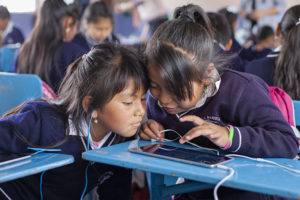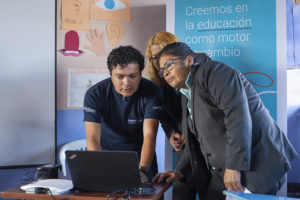We’ve already mentioned how next year’s UNESCO GEM Report will focus on analysing the role of technology in advancing education around the world and provided an overview of the main lines of investigation upon which the report will be based. Today we’d like to share the main lessons learnt from the experience of an organisation such as ProFuturo in terms of these lines of enquiry. How can technology be used to overcome challenges such as the access, quality and equity gaps? What are the main risks and how can we prevent them? How can technology be appropriately incorporated into education systems in vulnerable environments? Continue reading…
Educational challenges addressed by means of technology
What have we learnt about the role of technology when it comes to addressing challenges related to access, equity and inclusion?
Before answering this question, we should clarify that when we talk about remote and vulnerable environments, the solution to this challenge involves achieving a balanced combination of three elements: access, equity and inclusion. Finding this balance entails:
- Seeking solutions beyond the connected world, with offline answers that enable the transition to the online environment, should the need arise.
- Allowing “integrated” technology (hardware, software, installed contents, monitoring, etc.) to be incorporated in the most disconnected and/or remote environments.
- Facilitating basic techno-pedagogical training to enable teachers and educational leaders to join the dynamics of educational innovation.
- Working in emergency environments in a systemic manner so that EdTech enables the creation of quality education in them.
- Opening up resources to entities and individuals who have to rely on training plans for teachers and quality contents for the classroom which are always duly “organised” to meet the needs of those with fewer resources.

What have we learnt about the role of technology when it comes to addressing the challenges related to quality?
Enabling children in vulnerable environments to learn by using computers and electronic devices with the support and ongoing dedication of a duly trained teacher is one of the fundamental keys to skill enhancement. More specifically in the basic competence areas of maths and reading and writing, as well as certain skills for adult life that reinforce the improvement of the students’ interaction with their environment. We’ve seen this with the implementation of projects such as Jump Math, Mathematics ProFuturo and Club 2030.
This is also the case of digital competences, which are central to our era and not merely digital, referring to essential soft skills such as communication and collaboration, information processing, critical thought, content creation/creativity, problem-solving and security. We’ve seen this in projects such as LevelUp, Docentes Digitales and Entre Profes.
What have we learnt about the role of technology when it comes to addressing the challenges related to technological development?
This is where one of the disciplines we’ll be hearing about in the coming years comes into play, namely computational thinking, in which the two competence areas mentioned in the previous point converge: logical-mathematical and literacy skills and digital and soft skills.
As far as computational thinking is concerned, we’ve seen that it not only reinforces an essential area of the logical-mathematical competence based on problem-solving, but also that it does so by progressively adapting to the possibilities and needs of children and teachers from vulnerable environments. It also combines digital and soft skills to empower citizens committed to their environment and to immerse them in the language of the future, one that’s dominated by artificial intelligence and robotics.
What have we learnt about the role of technology when it comes to addressing the challenges related to the management of the education system?
One of the central axes that should characterise socio-educational intervention programmes with the digital world should necessarily involve data analytics. Not only to incorporate learning about efficient processes and outcomes into daily work with a view to continuous improvement, but also to provide “smart data” to the leaders of the educational change: the teachers. The properly analysed information management should be shared with partners, schools and teachers to enable them to understand and recognise the evidence of learning and the success factors in the teaching processes. Concepts such as a dashboard, continuous evaluation with data and adaptive personalisation are possible when the results are based on duly processed and analysed data.
How to prevent the risks of technology
What have we learnt about the potential negative impact of technology on access, equity and inclusion?
We know that the great failures of the EdTech world in our contexts lie in “technologisation” without the simultaneous incorporation of educational innovation. Technology without pedagogical innovation. While this is true in all educational contexts, it becomes much more relevant in vulnerable ones where, in addition, a third component comes into play, namely the need for approaches specifically designed for these environments that take into account, for example, the centrality of collaborative work, consideration of socio-emotional factors and the need to accelerate immersive and personalised learning processes. These issues are not usually addressed in a systemic manner in other educational programmes.
What have we learnt about the potential negative impact of technology on the quality of education?
As we’ve just remarked, one of the potential risks of technology in education is the mere technological replication of obsolete educational models that don’t adapt to the contexts in which they’re developed and don’t improve the students’ skills. Technology broadens the potential for more appropriate models such as competence-based work. However, the key will always lie in adequate teacher training, which must be geared towards the triple innovative dynamic that the EdTech challenge demands: pedagogical/educational innovation, digital innovation and, in vulnerable environments, innovation in social intervention.
What have we learnt about the potential negative impact of technology on technological development?
In this regard, the biggest problem that can be observed in education by means of technology is excessive admiration for technology. This is a somewhat totemic view that implies a false belief that the incorporation of technology can resolve any problem that arises. The solution to this problem lies, once again, in the appropriate hybridisation of technology with educational practices. The danger of ending up with “technology-dependent” learners can be addressed with a view of technology that’s well-embedded in learning processes, allowing the students to play a prominent role in the appropriate use of technology to “activate” their learning and competences. In this case, we can return to the example of computational thinking, whereby the student masters and controls the machine’s language rather than being controlled by it.
In short, education systems, schools and education professionals should regard technology as a central variable in their pedagogical planning, without forgetting that pedagogy (based on innovation) must always constitute the basis for their system.
What have we learnt about the potential negative impact of technology on the management of the education system?
The paralysis of the functioning and monitoring of the data management systems due to data overloads is a recurrent danger for them. In the future this may become a problem for our education systems as more and more data are generated via different educational and administrative platforms.
It’s therefore urgent to design and implement a suitable data management policy, with the incentive of the incorporation of artificial intelligence into its multiple derivatives in educational systems: suitable platforms, experts and companies to accompany the implementation processes and training at different levels for the agents involved (public administration managers, rectors, teachers, etc.).
Because incorporating smart algorithms into the daily activity of schools will guarantee proper monitoring of the programmes, adequate educational and administrative monitoring of the students, the incorporation of suitable public measures to resolve problems and, above all, simpler and less demanding administrative management.
How to avoid gaps between students and schools
These gaps aren’t just access gaps. We can also talk about gaps in the pedagogical use of technology. This pedagogical use requires training on how to use technology in the classroom for the teachers and schools. This will only be possible by means of a systemic implementation that regards the school as a place of intervention and positions the teachers and directors at the helm of this transformation. Only by empowering these institutions will countries be able to ensure that technology is a truly effective tool for improving the quality of education and that the digital world doesn’t create division like the additional socio-economic gap but is rather a means of reducing it.
How to incorporate technology into the most vulnerable education systems
Reforming curricula
In this regard there is a need for a curricular adjustment to focus on the acquisition of competences rather than the learning of contents. Fundamental digital cross-cutting competences are some of the most important ones. Technology is an essential resource enabling teachers and students to work on competences. However, speedier progress is required with regard to issues such as the inclusion of computational thinking in national curricula, the certified habilitation of digital competences in the classroom practice and suitable provision for the teachers for their collaborative networking and ongoing training.
The redesign of teaching materials
With the irruption of technology in the classroom, the textbook must evolve towards the world of the so-called Digital Educational Resources. Competence-based work also entails a new role for teachers as the creators, developers and curators of their own digital contents for the classroom. This is a complex task (particularly in vulnerable environments) but one that’s essential for bridging the socio-cultural and digital divides.
Means and training are required to learn how to use the huge capacity of technology (platforms, open resources, etc.) and ensure that the teaching materials serve this “new digital education”. Public institutions are also required to create the appropriate legal frameworks to ensure that the digital resources created by the different organisations can be provided to the collectives that most need them for their use, modification and enjoyment.
Support for the teaching personnel
All this is absolutely impractical without the participation of the teaching personnel, which is why the support and accompaniment of their role and work is a key element in the whole process of incorporating technology into education. This support should not only be understood in terms of adequate, practical, collaborative and ongoing training from the beginning of their professional career; all their recognition and efforts must also be properly accredited in traditional and digital ways (e.g. through micro-credentials) and they must be provided with the appropriate means in keeping with their needs and possibilities (adapted training pathways, on-demand training, open smart resource environments, adapted training pills, etc.).
In short, the application of technology to education in vulnerable environments can help to overcome many of the major access, equity, inclusion and quality issues facing education systems in many countries. However, we must never forget that technology is a means and not an end in itself and that, if it is to serve the purpose of bridging educational divides, “digital pedagogy” and the related teacher training must lie at the centre of our vision.







